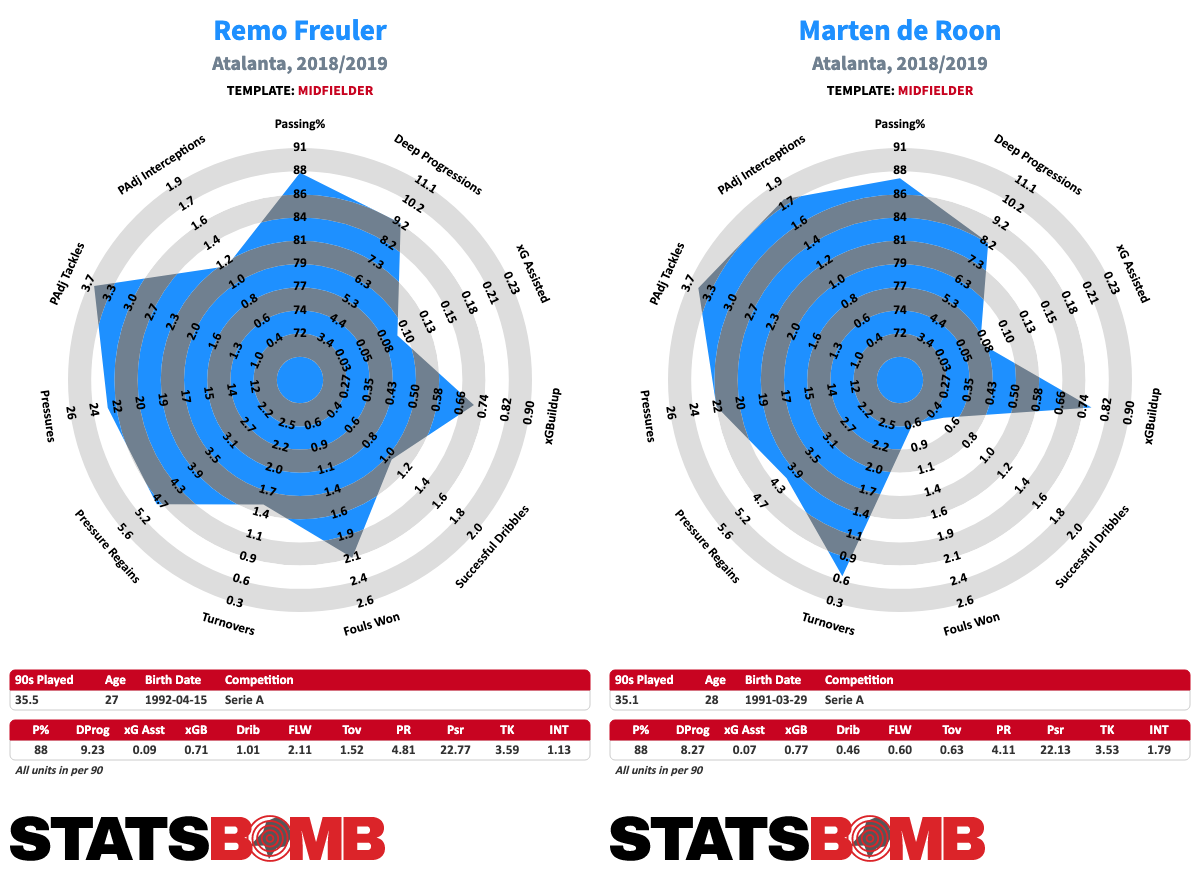Tonight, Atalanta will play the first Champions League game in their history. The crowning (at least for now) of a project that began nine years ago, when Antonio Percassi bought the club, then just relegated to Serie B, from the Ruggeri family. The team only needed a year to return to Serie A, but in the next five seasons their best result was the eleventh place in 2013-14. Three seasons ago, however, with the arrival of Gian Piero Gasperini on the bench, the team took a quantum leap sized step forward considering how set in stone the hierarchies of Italian football are, moving from 13th place in the previous season to 4th place with a club-record 72 points that granted them the qualification to the Europa League. The following domestic campaign was marked by the seventh place in the league, which again earned them qualification to the Europa League, which they had been eliminated from by Borussia Dortmund in the round of 32 the year before. The definitive breakthrough into a top club in Italian football came last season with Gasperini who, with the help of newly acquired Duvan Zapata, definitively turned the “Dea” into a goal machine, capable of scoring 77 goals in the Serie A 2018-19, a season record, and of literally bombarding opposing teams, as Empoli’s players, which last season faced 47 shots (!!!) in a goalless game, know well. 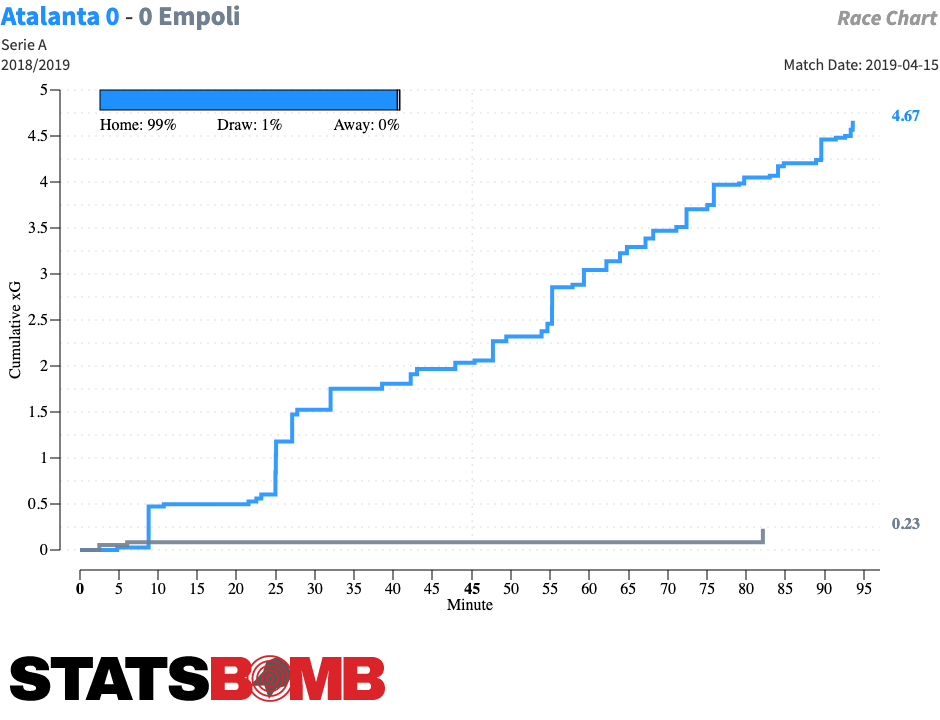 Atalanta also led the league in non-penalty xG with 63.61 and were second only to Napoli in shots per game (16.9). Those are three numbers that effectively describe their powerful attack, capable not only of generating opportunities at will but also of converting them at an above-average rate (apart from that game against Empoli).
Atalanta also led the league in non-penalty xG with 63.61 and were second only to Napoli in shots per game (16.9). Those are three numbers that effectively describe their powerful attack, capable not only of generating opportunities at will but also of converting them at an above-average rate (apart from that game against Empoli). 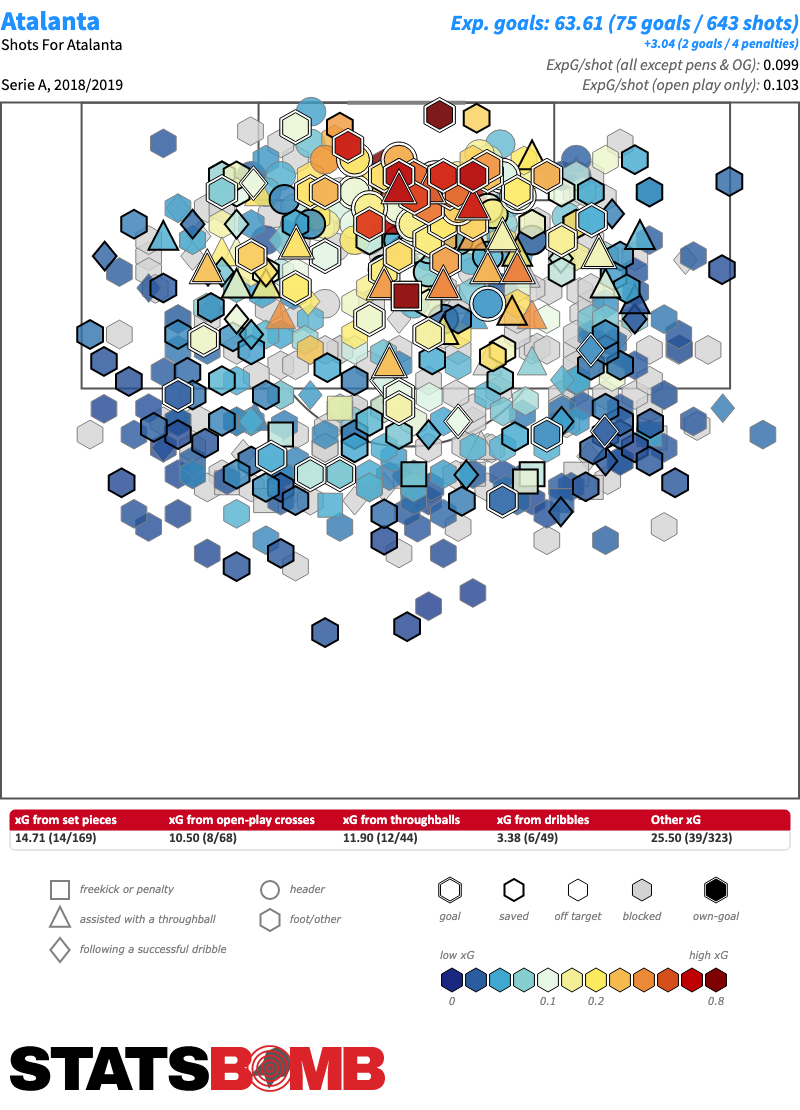 But that's not all, because last season Atalanta led the Serie A in practically every offensive statistic. Indeed, thanks to their ability to consistently play the ball inside the opposing area (137 passes inside the box, at least 20 more than any other team), the average shot distance of their 643 attempts was just 15.52 meters, the shortest in the league. Analyzing their scoring in greater depth, they scored 14 goals from set pieces (10 from corners) while generating a league-best 14.59 xG from dead ball situations. They were also particularly good at generating chances from throughballs (only Napoli created more chances this way), which they converted at a 27.3% rate (12 goals from 44 throughballs). Together, throughballs and set pieces accounted for more than 41% of the xG Atalanta generated last season. Such a high amount is not an accident and signals the high understanding by Gasperini and his players of the importance of two fundamental offensive tools in football. In fact, as you may know if you are a regular reader of these pages, throughballs are by definition the most effective type of assist, while set pieces, however neglected, are a weapon that constitutes a true game changer in a sport with such low margins. In all fairness, though, last season didn’t start well for Atalanta, with the black and blue team able to win just one of their first eight matches. After a 5-1 away win against Chievo in late October things started to get better, but the real turning point of the season was a change in the offensive system. They were still just seventh on table when Gasperini decided to move Alejandro Gomez in the trequartista role.
But that's not all, because last season Atalanta led the Serie A in practically every offensive statistic. Indeed, thanks to their ability to consistently play the ball inside the opposing area (137 passes inside the box, at least 20 more than any other team), the average shot distance of their 643 attempts was just 15.52 meters, the shortest in the league. Analyzing their scoring in greater depth, they scored 14 goals from set pieces (10 from corners) while generating a league-best 14.59 xG from dead ball situations. They were also particularly good at generating chances from throughballs (only Napoli created more chances this way), which they converted at a 27.3% rate (12 goals from 44 throughballs). Together, throughballs and set pieces accounted for more than 41% of the xG Atalanta generated last season. Such a high amount is not an accident and signals the high understanding by Gasperini and his players of the importance of two fundamental offensive tools in football. In fact, as you may know if you are a regular reader of these pages, throughballs are by definition the most effective type of assist, while set pieces, however neglected, are a weapon that constitutes a true game changer in a sport with such low margins. In all fairness, though, last season didn’t start well for Atalanta, with the black and blue team able to win just one of their first eight matches. After a 5-1 away win against Chievo in late October things started to get better, but the real turning point of the season was a change in the offensive system. They were still just seventh on table when Gasperini decided to move Alejandro Gomez in the trequartista role. 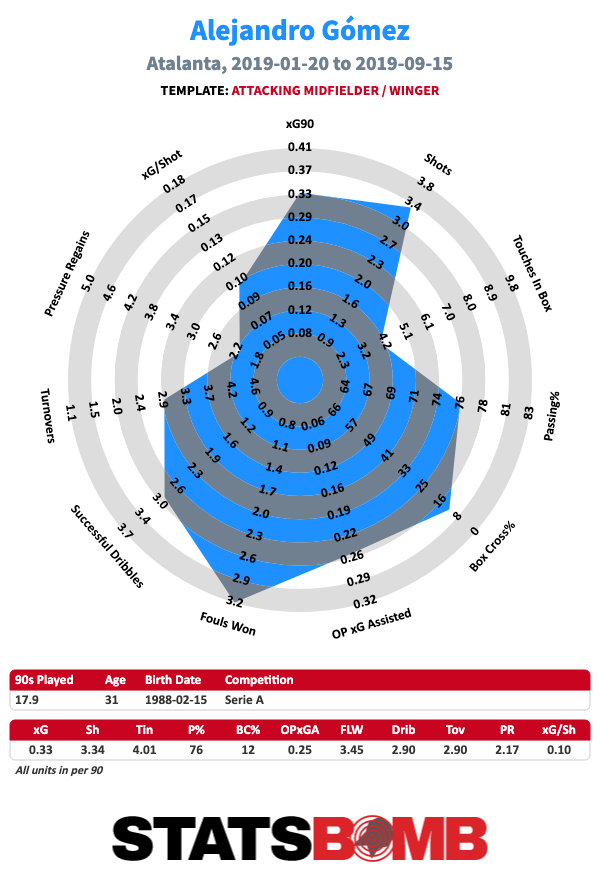 The new 3-4-1-2 with “Papu” behind the two strikers, Josip Ilicic (free to dominate the right-halfspace) and Duvan Zapata further improvesd Atalanta's offensive production and allowed them to move up the rankings and ultimately clinch third place, going unbeaten in the last 13 games of the season. Defensively, Atalanta were a top-5 team, but they performed under expectations. Gasperinis’ was the best team in preventing opposing shots, with opponents that were able to fire just 407 shots last season, but the average xG of their open-play shots conceded was at 0.095, a tad high for Serie A. Still, while they conceded 42 goals, their opponents amassed only 36.21 xG. Their defensive system is based on man-marking and encourages individual duels, while also requiring concentration, anticipation and great physical intensity. The “Dea” tries to limit as much as possible their opponent's time on the ball, which, to use their manager’s own words, generates "anxiety" in him. Their passes per defensive action (PPDA) of 7.94 (2nd) demonstrates their will to regain the ball high and as soon as possible, a real trademark of their manager.
The new 3-4-1-2 with “Papu” behind the two strikers, Josip Ilicic (free to dominate the right-halfspace) and Duvan Zapata further improvesd Atalanta's offensive production and allowed them to move up the rankings and ultimately clinch third place, going unbeaten in the last 13 games of the season. Defensively, Atalanta were a top-5 team, but they performed under expectations. Gasperinis’ was the best team in preventing opposing shots, with opponents that were able to fire just 407 shots last season, but the average xG of their open-play shots conceded was at 0.095, a tad high for Serie A. Still, while they conceded 42 goals, their opponents amassed only 36.21 xG. Their defensive system is based on man-marking and encourages individual duels, while also requiring concentration, anticipation and great physical intensity. The “Dea” tries to limit as much as possible their opponent's time on the ball, which, to use their manager’s own words, generates "anxiety" in him. Their passes per defensive action (PPDA) of 7.94 (2nd) demonstrates their will to regain the ball high and as soon as possible, a real trademark of their manager. 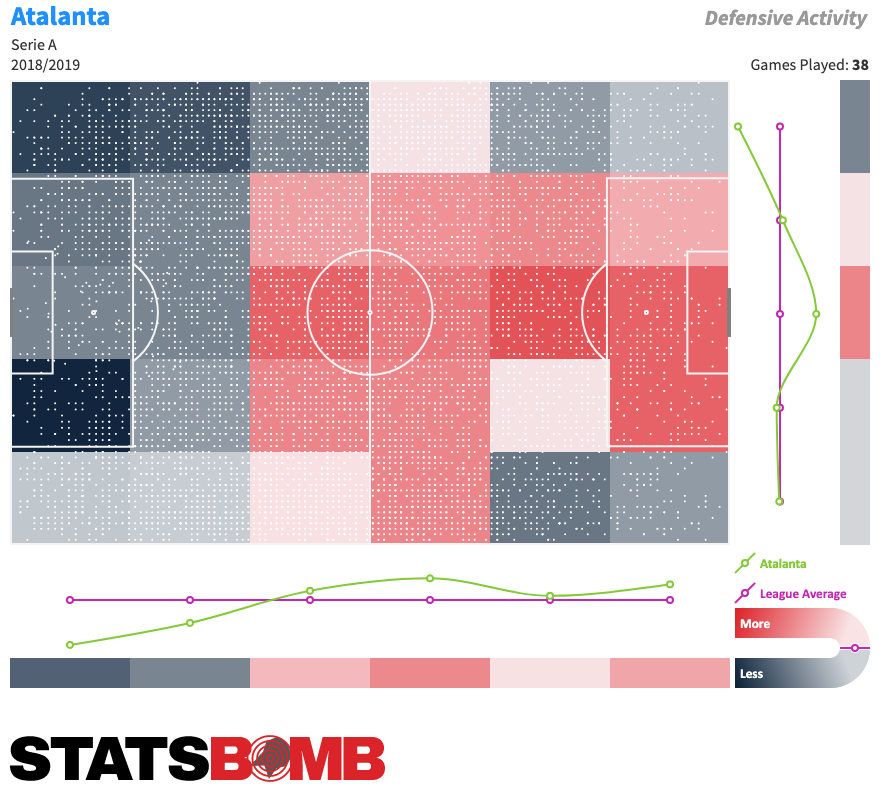 Even if this approach is often effective, if one of the defenders is dribbled past or misjudges an opposing play, Atalanta can become quite exposed and the ball carrier can find himself with an open path to the goal.
Even if this approach is often effective, if one of the defenders is dribbled past or misjudges an opposing play, Atalanta can become quite exposed and the ball carrier can find himself with an open path to the goal. 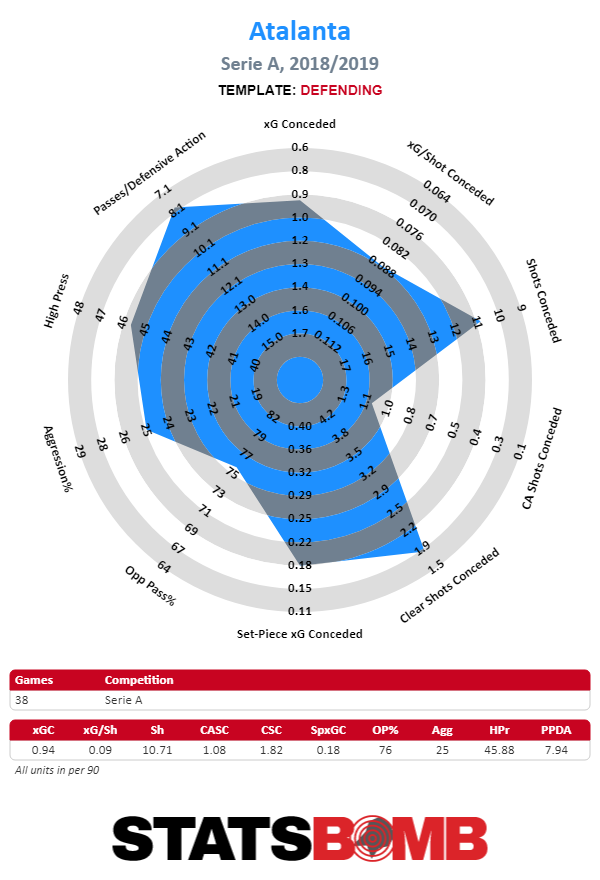 This tactical element partly explains their under-performance but there is more: at keeper Etrit Berisha, replaced by Pierluigi Gollini over the summer, had a negative shot stopping percentage as compared to an average keeper (-2%) signaling under average performances which exacerbated the problem, but above all, defense on set pieces was far from efficient. Despite 6.89 set piece xG allowed, Atalanta conceded 11 goals from dead ball situation an amount that has almost nullified their excellent results in offensive set pieces. However, apart from the necessary improvements in defending set pieces, I would not consider Atalanta’s defense as a liability. Actually, one of their strengths, is that Gasperini does not have to rely on one or more pivotal defenders, but he can rotate the three center backs without compromising their defensive performance. Last season we saw 9 different center back combination in 38 games. Thus, the loss of Gianluca Mancini, who was sold to Roma, shouldn’t be a huge blow for their defence, considering that he has been replaced with Simon Kjaer. In the first three games of this season, Atalanta collected six points, losing their opening game against Torino and winning the following two against SPAL and Genoa. The attack showed no signs of slowing down and with the addition of Luis Muriel as their super-sub (two open play goals out of 0.35 xG plus one penalty scored), the “Nerazzurri” have buried their opponents under 22.3 shots per game (first in the league). Although not very relevant considering the sample size, their average xG/shot has declined of around 20% but throughballs are still a distinguish feature of Atalanta’s chance creation since out of a total of 5.36 xG generated (2nd), 2.06 come from throughballs. So far, they rank fourth in opponent shot per game (11.3), but they have already conceded 6 goals out of 3.36 xG, an inconsistency that can be a wake-up call even if it's way too early to draw any conclusions. All in all, underlying numbers, especially the offensive ones, suggest that Gasperini’s team started their season as if the past was never over. But this season they also have more depth, since during the transfermarket they also brought in Brazilian wingback Guilherme Arana from Sevilla and versatile Ukrainan midfielder Ruslan Malinovskyi. Key Players Despite being a coach with clear principles of play, Gasperini has always had the ability to put certain players in a position to maximize their potential, tailoring roles and tasks that enhance their specific qualities. Examples are two pressing-machines like Remo Freuler and Marten De Roon, who thrived in Atalanta’s system, posting very good defensive numbers, especially in possession adjusted tackles, while also providing important contributions in build-up and deep progressions.
This tactical element partly explains their under-performance but there is more: at keeper Etrit Berisha, replaced by Pierluigi Gollini over the summer, had a negative shot stopping percentage as compared to an average keeper (-2%) signaling under average performances which exacerbated the problem, but above all, defense on set pieces was far from efficient. Despite 6.89 set piece xG allowed, Atalanta conceded 11 goals from dead ball situation an amount that has almost nullified their excellent results in offensive set pieces. However, apart from the necessary improvements in defending set pieces, I would not consider Atalanta’s defense as a liability. Actually, one of their strengths, is that Gasperini does not have to rely on one or more pivotal defenders, but he can rotate the three center backs without compromising their defensive performance. Last season we saw 9 different center back combination in 38 games. Thus, the loss of Gianluca Mancini, who was sold to Roma, shouldn’t be a huge blow for their defence, considering that he has been replaced with Simon Kjaer. In the first three games of this season, Atalanta collected six points, losing their opening game against Torino and winning the following two against SPAL and Genoa. The attack showed no signs of slowing down and with the addition of Luis Muriel as their super-sub (two open play goals out of 0.35 xG plus one penalty scored), the “Nerazzurri” have buried their opponents under 22.3 shots per game (first in the league). Although not very relevant considering the sample size, their average xG/shot has declined of around 20% but throughballs are still a distinguish feature of Atalanta’s chance creation since out of a total of 5.36 xG generated (2nd), 2.06 come from throughballs. So far, they rank fourth in opponent shot per game (11.3), but they have already conceded 6 goals out of 3.36 xG, an inconsistency that can be a wake-up call even if it's way too early to draw any conclusions. All in all, underlying numbers, especially the offensive ones, suggest that Gasperini’s team started their season as if the past was never over. But this season they also have more depth, since during the transfermarket they also brought in Brazilian wingback Guilherme Arana from Sevilla and versatile Ukrainan midfielder Ruslan Malinovskyi. Key Players Despite being a coach with clear principles of play, Gasperini has always had the ability to put certain players in a position to maximize their potential, tailoring roles and tasks that enhance their specific qualities. Examples are two pressing-machines like Remo Freuler and Marten De Roon, who thrived in Atalanta’s system, posting very good defensive numbers, especially in possession adjusted tackles, while also providing important contributions in build-up and deep progressions. 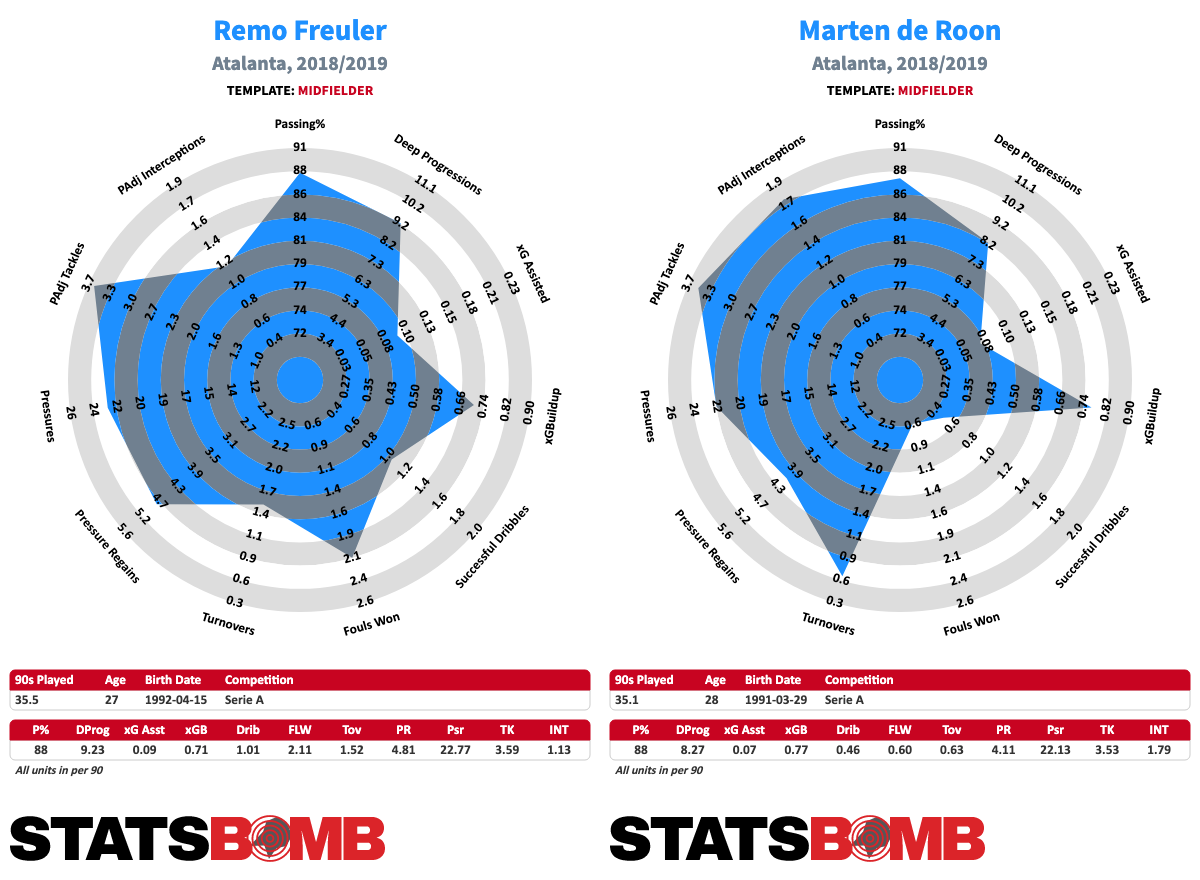 But every football fan should be grateful to Gasperini for giving us the best Ilicic ever. Now that he's over 30, one of the purest talents of the Serie A of the 21st century has finally found the ideal team to shed critics and put his crystal-clear class and creative ingenuity at the service of one of the bravest technical-tactical experiments of European football. Running Ilicic’s last season in the StatsBomb compare-o-meter, the first five seasons that come out are (*drum rolls*) two season from Neymar and three from Messi. You know what I'm saying? Last season the Slovenian was really the MVP of Serie A. But if Ilicic was the best player of last season, his attacking partner Zapata was the one who scored the most. The Colombian, who had never scored more than 11 times in a season, scored 23 goals in the league, literally shouldering his way into the box, as he did here against Torino.
But every football fan should be grateful to Gasperini for giving us the best Ilicic ever. Now that he's over 30, one of the purest talents of the Serie A of the 21st century has finally found the ideal team to shed critics and put his crystal-clear class and creative ingenuity at the service of one of the bravest technical-tactical experiments of European football. Running Ilicic’s last season in the StatsBomb compare-o-meter, the first five seasons that come out are (*drum rolls*) two season from Neymar and three from Messi. You know what I'm saying? Last season the Slovenian was really the MVP of Serie A. But if Ilicic was the best player of last season, his attacking partner Zapata was the one who scored the most. The Colombian, who had never scored more than 11 times in a season, scored 23 goals in the league, literally shouldering his way into the box, as he did here against Torino. 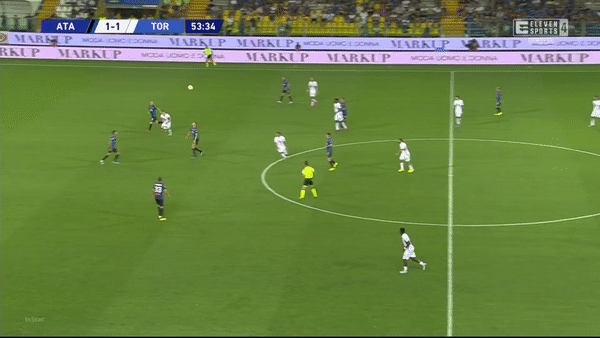 Last season he generated 0.43 xG out of 3.4 shots every 90 minutes. This season he is at 0.63 xG from 5.5 shot per 90. Such a physically dominant striker who could score so much hadn't been seen in Serie A for a long time. Defenders of Champions League Group C should be scared.
Last season he generated 0.43 xG out of 3.4 shots every 90 minutes. This season he is at 0.63 xG from 5.5 shot per 90. Such a physically dominant striker who could score so much hadn't been seen in Serie A for a long time. Defenders of Champions League Group C should be scared.
Conclusion
Recent experiences in the Europa League and last season's Coppa Italia final have shown that Atalanta can fight on multiple fronts. Yet, few competitions consume physical and mental energy like the Champions League does. The draw put them in front of Manchester City, Dinamo Zagreb (who they play tonight) and Shakhtar Donetsk. While Pep Guardiola’s team is clearly on another level (even though I am pretty sure the “Nerazzurri” could cause difficulties for them), they have everything they need to clinch the second spot. Atalanta will face the challenge head-on and have all the necessary qualities (unique tactical style, high goal-scoring potential, a ton of players to watch) to impress Europe. If they succeed in passing the first round, they could even become the wild card of the competition, emulating Ajax last season. The club already has one of the best, if not the best, youth sector in the country, has its own stadium on which it is carrying out renovation and expansion work (the home games of Champions League will be played in San Siro), a well-structured management and balance sheets largely in surplus in the last two years. And the situation is likely to get better since the money guaranteed by the participation in Europe plus TV rights will be around €25 million. Whatever the outcome, the first participation in the biggest European competition represents a milestone for a team dedicated to joining Italy's elite.
